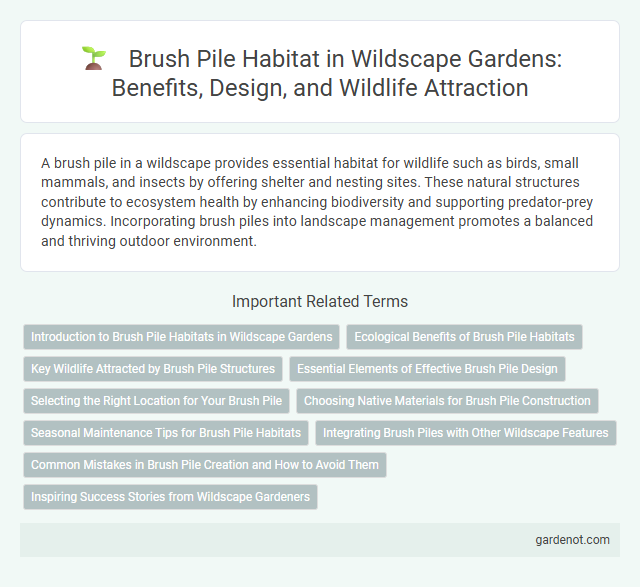A brush pile in a wildscape provides essential habitat for wildlife such as birds, small mammals, and insects by offering shelter and nesting sites. These natural structures contribute to ecosystem health by enhancing biodiversity and supporting predator-prey dynamics. Incorporating brush piles into landscape management promotes a balanced and thriving outdoor environment.
Introduction to Brush Pile Habitats in Wildscape Gardens
Brush pile habitats in Wildscape Gardens provide essential shelter and nesting sites for diverse wildlife, including birds, small mammals, and insects. These natural structures consist of stacked branches, twigs, and leaves that create a microhabitat supporting biodiversity and promoting ecological balance. By fostering native species and enhancing food web interactions, brush piles contribute to the overall health and sustainability of Wildscape ecosystems.
Ecological Benefits of Brush Pile Habitats
Brush pile habitats provide critical shelter and nesting sites for a variety of wildlife species, including birds, small mammals, and insects, enhancing local biodiversity. These structures promote soil health by slowing erosion and retaining moisture, contributing to ecosystem stability and resilience. The decomposing wood in brush piles creates nutrient-rich environments that support fungi and microorganisms essential for nutrient cycling.
Key Wildlife Attracted by Brush Pile Structures
Brush pile structures attract key wildlife such as small mammals including rabbits and chipmunks, which use the dense cover for shelter and nesting sites. These piles also provide habitat for a variety of bird species like quail, pheasants, and wild turkeys that forage and nest within the tangled branches. Reptiles and amphibians, such as snakes and frogs, benefit from the moisture retention and protection offered by brush piles, enhancing overall biodiversity in a wildscape.
Essential Elements of Effective Brush Pile Design
Effective brush pile design for wildscapes prioritizes structural complexity, size, and location to maximize wildlife habitat benefits. Incorporating a mix of branches with varied diameters and creating layered, dense piles ensures shelter and nesting opportunities for small mammals, birds, and beneficial insects. Positioning brush piles near water sources or natural cover enhances accessibility and safety, supporting biodiversity and ecosystem health.
Selecting the Right Location for Your Brush Pile
Selecting the right location for your brush pile significantly impacts its effectiveness in supporting wildlife habitat. Choose a site with minimal disturbance, ideally near natural food sources and away from heavy foot traffic to provide shelter and nesting opportunities for birds, small mammals, and reptiles. Ensure the area has good drainage to prevent moisture buildup, which can cause decay and reduce the pile's longevity and usefulness as a wildlife refuge.
Choosing Native Materials for Brush Pile Construction
Selecting native hardwood branches and twigs ensures brush piles provide optimal shelter for local wildlife, promoting ecosystem health. Using materials like oak, hickory, or maple supports native insect populations and offers natural camouflage for birds and small mammals. Avoiding non-native or treated wood prevents introducing harmful chemicals and invasive species into the habitat.
Seasonal Maintenance Tips for Brush Pile Habitats
Brush piles provide essential shelter and nesting sites for wildlife, especially during colder months. Seasonal maintenance involves removing decomposed material in late winter to prevent mold and pests, while adding fresh branches and twigs in early spring supports new habitat growth. Regularly rotating brush layers enhances air circulation and promotes a healthy ecosystem for birds, small mammals, and beneficial insects throughout the year.
Integrating Brush Piles with Other Wildscape Features
Integrating brush piles with other wildscape features enhances wildlife habitat complexity and biodiversity by providing essential shelter and foraging opportunities for small mammals, birds, and insects. Strategically placing brush piles near native plant clusters, water sources, and nesting boxes maximizes ecological interactions and supports diverse species throughout the year. This synergy fosters a balanced ecosystem, promoting natural pest control and nutrient cycling within wildscape environments.
Common Mistakes in Brush Pile Creation and How to Avoid Them
Common mistakes in brush pile creation include using only green, fresh branches that decay slowly and attract fewer wildlife species, as well as placing piles in exposed areas rather than near natural cover. Avoid compacting the pile too tightly, which limits shelter space, and instead arrange branches loosely to promote airflow and diverse habitats. Properly constructed brush piles using a mix of dry and green materials in secluded, shaded spots increase habitat value for birds, small mammals, and beneficial insects.
Inspiring Success Stories from Wildscape Gardeners
Wildscape gardeners have transformed humble brush piles into vibrant habitats, demonstrating innovative techniques that boost biodiversity and attract native wildlife. These success stories highlight how decomposing branches provide essential shelter for insects, birds, and small mammals, fostering a thriving ecosystem. By repurposing natural debris, gardeners contribute to sustainable gardening practices while enriching local flora and fauna.
Brush pile Infographic

 gardenot.com
gardenot.com